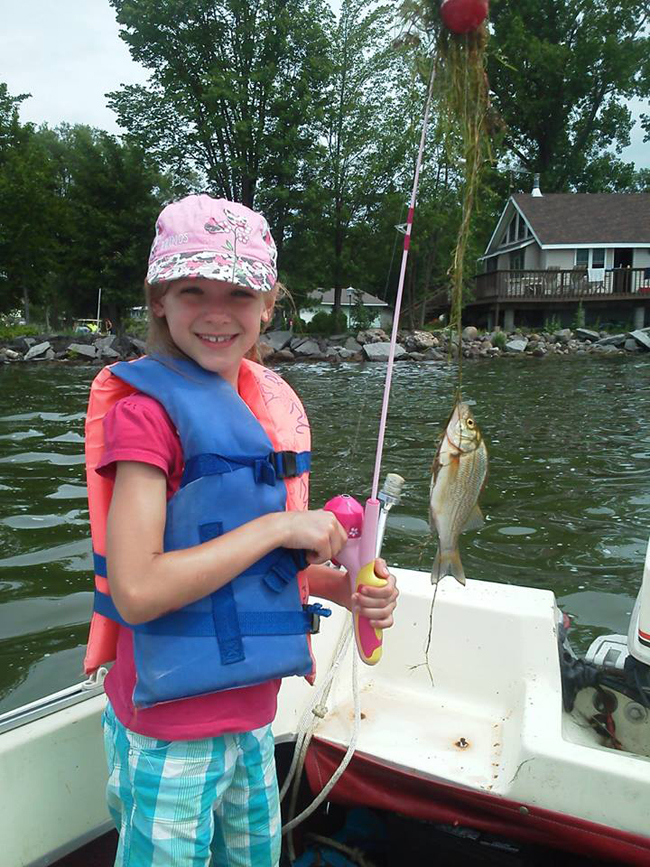
Shae Penney poses with her catch of the day (most likely a white perch) at North (Sandy) Pond, an embayment of Lake Ontario. Identification of the species is often a challenge: "The only way to tell the difference between a white perch and a white bass is whether the spiny and soft dorsal were connected or not," says NYSG Fisheries Specialist Dave MacNeill.
Syracuse, NY, May 1, 2014 - Coastal businesses in the Lake Ontario region
—Jefferson, Oswego, Cayuga, Wayne, Monroe, Orleans, and Niagara counties
—depend greatly on anglers for income. As part of its goal to promote robust coastal business development, New York Sea Grant funded a study of Lake Ontario resident anglers, a large and fairly stable angler group whose travel within the Lake Ontario region is less affected by high fuel costs and the state of the economy than non-resident anglers.
A research team from the State University of New York College of Environmental Science and Forestry conducted a mail and online survey of a random sample of 7,000 property owners in the counties bordering Lake Ontario in New York State. The purpose of the study was to understand the motivations, constraints, and facilitators specific to resident fishing efforts to inform future fisheries management, and sportfishing promotion and marketing efforts in the Lake Ontario region. For this study, motivations are the forces that drive people to achieve particular recreational goals, constraints limit participation, and facilitators are facts that enable participation.
The results were published in a 21-page booklet entitled:
Lake Ontario Resident Anglers: Motivations, Constraints, and Facilitators co-authored by
Diane Kuehn,
Gregory Durante,
Matthew Brincka, and
Valerie Luzadis of the State University of New York College of Environmental Science and Forestry and NYSG’s Fisheries Specialist
Dave MacNeill.
The research results indicate that New York’s Lake Ontario-resident anglers fish primarily for the enjoyment of fishing, as well as to spend time with friends and family in nature, and to expand their fishing skills and success at catching fish. Providing and promoting fishing experiences that focus on the social side of fishing, spending time in nature, and the thrill of reeling in a fish would likely be most effective for increasing the interest of these resident anglers in fishing.
With regard to constraints and facilitators, assessment of the amount of shoreline access is likely needed to ensure adequate boat launch facilities and shoreline fishing access.
Confirmatory factor analyses and an analysis of variance were used to study differences among angler groups —those that fish for smallmouth bass, largemouth bass or walleye anglers. Descriptive statistics were used to identify differences in fishing characteristics and demographics. The angler groups with the highest number of fishing trips to Lake Ontario, its tributaries, and embayments in 2009 were walleye and panfish anglers. The largest group of anglers included residents having no preference for any one species of fish; this group also had the largest percentage of female anglers (20%) of all angler groups. Motivations found to most encourage anglers to fish were affiliation with others, personal achievement, nature appreciation, and enjoyment. Factors identified by respondents as constraints to fishing participation were time and bad weather. The factors found to most enable participation (facilitators) were good weather and past experience with fishing as a child or teenager.
Due to the large percentage of female anglers in the “no-preference” group, programs focused on female anglers should consider the motivations of no-preference anglers when organizing educational programs and determining promotional strategies.
Says researcher Kuehn, “It is recommended that future management efforts focus on enhancing fishing access, promoting the social/enjoyment aspects of fishing, and bringing more young and female anglers into the sport.”
In a follow-up project by Kuehn and
Eddie Bevilacqua (also of SUNY CESF), GIS Analysis of Resident Angler Fishing Characteristics and Demographics the researchers used GIS analysis to demonstrate that significant relationships exist between the proximity of an angler's residence to Lake Ontario and both the average number of fishing trips per year and an angler's perceptions concerning the availability of fishing access. These results can be used by tourism promotion agencies and state agency staff to identify counties where additional fishing access sites may be warranted. The results also indicate that more effort may be needed by tourism promoters and fisheries managers to increase the awareness of inland residents about potential fishing access sites.
—Barbara A. Branca, NYSG's Communications Manager
Lane Smith and Diane Kuehn contributed to this story
More Info: New York Sea Grant
New York Sea Grant (NYSG), a cooperative program of Cornell University
and the State University of New York, is one of 33 university-based
programs under the National Sea Grant College Program (NSGCP) of the
National Oceanic and Atmospheric Administration (NOAA). The NSGCP
engages this network of the nation’s top universities in conducting
scientific research, education, training and extension projects designed
to foster science-based decisions about the use and conservation of our
aquatic resources. Through its statewide network of integrated
services, NYSG has been promoting coastal vitality, environmental
sustainability, and citizen awareness about the State’s marine and Great
Lakes resources since 1971.
For updates on Sea Grant activities:
www.nyseagrant.org has RSS,
Facebook,
Twitter, and
YouTube links. NYSG also offers a free e-list sign up via
www.nyseagrant.org/coastlines for
NY Coastlines, its flagship publication, which, in 2014, merges with the program's e-newsletter,
Currents.
NY Coastlines is published several times a year.